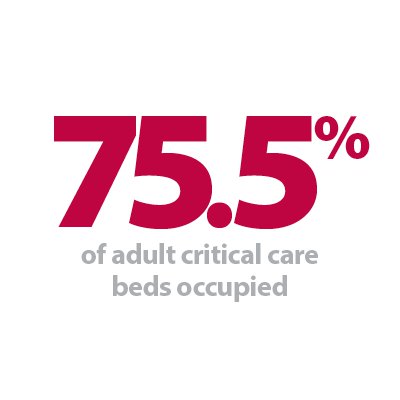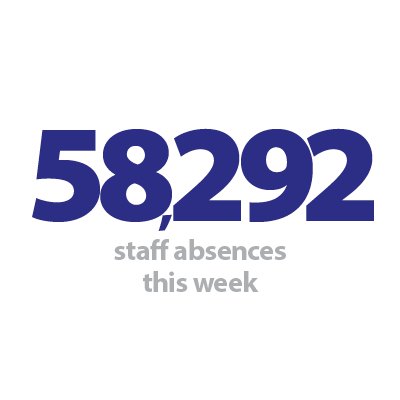


Today we saw the twelve week of the winter sit reps published by NHS England and NHS Improvement. It is also the day that COVID-19 restrictions in England are fully lifted by the government with no legal requirement to isolate if you have COVID-19. Nationally, the number of COVID-19 cases continues to fall, but levels remain much higher than the same time last year.
As of Tuesday 22 February, there were 30,080 new cases recorded in England, down by 18% since last week. In comparison to the start of 2022, cases are down by 81.5% but compared to the same time last year, cases remain three times higher. Looking at COVID-19 hospital statistics, there have also been weekly decreases in admissions (-5.6%), the number of patients in hospital (-10.7%) and the number of patients in mechanical ventilation beds (-12.1%).
While the reduction in COVID-19 hospital activity is undoubtedly encouraging, the latest winter sit reps data highlight the continued pressures trusts are facing as we reach the end of winter.
Key headlines from winter sitreps week 12 (14-20 February)
- There were no A&E closures again this week, however the number of A&E diverts climbed up again to 32 (9 more) and were almost double the number seen this time last year.
- The ambulance sector continues to experience increased pressures, with delays higher than the same time last year: 21% of ambulance handovers were delayed by 30 minutes or more (20% last week) and 8.5% were delayed by 60 minutes or more (8% last week). However, there was a slight decrease in the number of arrivals, with 1.1% fewer patients arriving by ambulance this week (84,574 total arrivals).
- Adult critical care bed occupancy remains at similar levels to last week at 75.5% and is again lower than the same time last year (77.4%). This is an encouraging figure considering the average number of critical care beds open this week is 30% lower than the same time last year, yet occupancy rates are lower this year.
- The number of beds closed due to diarrhoea and vomiting (D&V) and norovirus continues to fall this week, down by 10% to 203. This is still considerably higher than the same time last year when there were social distancing measures in place (+757%), but much lower than the same time two years ago before the pandemic (507).
- On average, there were 20,859 patients who no longer met the criteria to reside in hospital. Of these, 56.5% remained in hospital, a slight increase from 56.4% the week before. At the end of last week (20 Feb), 68.6% of patients who no longer met the criteria to reside have remained in hospital.
- There were fewer adult and paediatric general and acute (G&A) beds open this week (an average of 96,0679 or 674 more beds), yet the occupancy rate remained at 92.5%. Looking at adult beds, there were 90,392 beds open on average (up from 89,752 the week before and 934 more than one year ago), representing an occupancy rate of 93.8% (up from 85.2% the year before and at a similar level as week 11).
- This week there have been similar levels of patients staying in hospital longer than seven, 14 and 21 days compared to the previous week. However, these figures are all up from this time last year, by 26%, 35% and 45% respectively.
- Neonatal intensive care bed occupancy has increased this week to 67.1%, up from 66.2% last week, and considerably higher than the same time last year (64.1% last year). Paediatric intensive care bed occupancy has fallen again this week to 68.7%, down from 71.7% last week. However, this remains similar to the same time last year (68.1% last year). The average number of care beds open has fallen to 319, 2 more than last week and up by 16.9% compared to last year.
- The number of G&A beds occupied by flu patients increased this week to 186 (14 more). A total of 14 critical care beds were occupied by flu patients (2 fewer than last week). An average of 8 paediatric beds were closed this week due to RSV symptoms, 3 more than last week.
- There were 58,292 total absences this week (down from 62,777), of which 30% were COVID-19 related (17,250). Although there were still over 58,000 staff absences, these have been decreasing for six consecutive weeks now after peaking at week ending 9 January with 88,516 total staff absences of which over half (52%) were COVID-19 related.
This week we are once again seeing slight improvements in some of the figures, particularly fewer beds closed due to D&V, paediatric intensive care bed occupancy rates falling, and lower levels of critical care bed occupancy compared to last year. There were also some improvements in the ambulance sector, with the number of ambulance arrivals decreasing since the week before and reaching lower levels compared to those seen the same time last year.
The figures this week offer some encouragement as we move towards the end of the winter period, but it is important to note trusts are still under much more pressure than this time last year. For example, although there are more G&A adult beds open this year, we are seeing a higher occupancy rate compared to one year ago, suggesting demand is high and pressures are being felt by trusts. Staff absences have been particularly challenging and remain above 58,000 despite six consecutive weeks of decreasing numbers. Equally, system wide pressures across health and social care are still evident in these data, as delayed discharge figures show similar proportions of patients remaining in hospital after no longer meeting the criteria to reside this week.
Over the coming weeks, as the government's strategy to live with COVID-19 unfolds, it is of the utmost importance to keep monitoring these data to ascertain the impact of changes on the NHS.
NHS still working under great pressure
Responding to the latest winter reporting data from NHS England and NHS Improvement, the director of policy and strategy at NHS Providers, Miriam Deakin said:
"These figures offer some encouragement as we slowly move towards the end of the winter period, but we must also recognise that trusts are still under more pressure than this time last year.
"For example, A&E diverts are now double the number seen 12 months ago, and ambulance handover delays remain considerably higher too.
"The number of patients staying in hospital longer than seven, 14 and 21 days remains stable this week, albeit at a high level.
"Meanwhile, continuing high bed occupancy and increasing delayed discharges reflect real pressure across the entire health and care system.
"We are encouraged to see that staff absences continue to fall from the very high levels a few weeks ago.
"This week the government set out it's 'Living with COVID-19' strategy. Over the coming weeks, it'll be important that the government continues to closely analyse the data to assess the impact of any changes on the NHS."